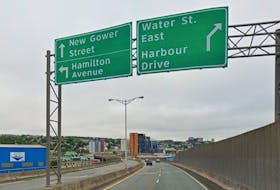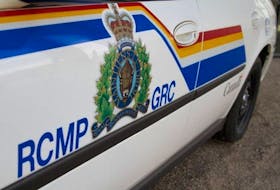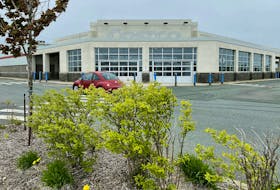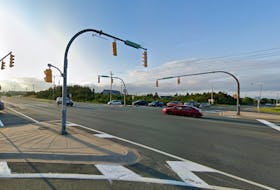TOOGOOD ARM, N.L. - During a freezing cold winter morning, Toogood Arm fisherman Bob Randell is down at the slipway on Twillingate Island, tearing out the back of his longliner.
To meet the 39’11 measurement limit, Randell has to cut off a couple feet from his “Beothic Transport” vessel, but he’s not pleased to have to tackle the work.
“By the time it’s said and done, I’ll have spent around $3,000-4,000 and that’s doing it myself. If I had to get someone else to do it it’d probably be a $10,000 job,” Randell said. “I don’t see the point of it. We’re all on individual quotas, so what difference do the size or length make? Whatever boat you got you quit fishing once you get your quota.”
This same sentiment has been voiced across the province, from harvesters like Rick Jones in Trinity, Keith Boland in St. John’s, and Richard and Melanie Marsh on Random Island, all of whom have had to invest their money, time, and labour to bring their boat to a 39’11 length.
In the fall of 2017, Richard had to cut less than two feet from his boat, but it came with a considerable cost.
“The money was the big thing. It cost us around $10,000 to take off one foot, eight inches,” he said. “We had to bring in a marine surveyor, put the boat up on the dock, take the back of it off completely, reframe it, plywood and fibre glass over it. Then we had to make more changes for our tanks to fit. It was a trying thing.
“What I would like to see is if I got a set quota, a set daily limit or weekly limit, then it should be up to me if I want to get a bigger boat to feel safer or more comfortable.”
Competition factor
While the Department of Fisheries and Oceans (DFO) administers the policy and ensures boat measurements are followed, harvesters like Randell say the Fish, Food and Allied Workers-Unifor union (FFAW-Unifor) plays a key role in keeping this policy in place.
“We were told by DFO if you had the support from the FFAW, this could be changed right away,” he said.
The current policy on commercial vessel requirements, established for Newfoundland in Labrador in 2007, requires most harvesters in the province register their boats either at the maximum of 39’11 fleet or the maximum of 65’ fleet. There is also a third fleet set at a maximum of 90’ length.
Inshore director with the FFAW-Unifor Bill Broderick says the fleet separation policy creates a level playing field and better protects the industry as a whole.
“It’s not about what it may cost individual people to cut off sections of their boat, but what it might cost the rest of this industry if we throw out the rule – that’s what we got to look at,” said Broderick.
“It’s easy to say you want a bigger boat for comfort or safety, but with that many will want more quota and to compete with the 65’ fleet. With the shrimp gone, these larger boats only have crab and turbot, none of them are doing particularly well. And if you let these smaller fleets go to 45’ or 55’, then they can fish in weather the 39’11 vessels can’t. Now those people feel they got no choice but to be forced into getting a bigger boat.
“You’d end up making both fleets uneconomical. We want to protect both these fleets, not make them less economical.”
However, both Randell and Marsh say there are larger vessels that fish in the same zones with the same quotas as their 39’11 enterprises.
“The union is representing three different classes of fishermen, and the ones that got the most say is the ones with the most quota and that’s the bigger boats,” said Randell. “The people in the 65’ fleet will say don’t let them extend their boats they’ll go out there and catch our fish. But when the cod opened up, everyone was fishing in the grounds we use, these larger boats were coming right close to the rocks to catch cod.”
Safety risks
Jason Sullivan, harvester and secretary-treasurer with the Federation of Independent Sea Harvesters of Newfoundland and Labrador (FISH-NL), says the restriction to 39’11 also poses safety risks to the harvesters in this fleet. Particularly with the need for additional space some crab harvesters would like, Sullivan sees this restriction causing more problems than it solves.
“From a safety standpoint it seems like we’re moving backwards,” Sullivan said. “If you wanted a deck installed so you’re not overloaded with your crab gear, that would be good to give you some extra room.
“Typically, it’s a safer environment if you have more space.”
As the weather changes the conditions along the province’s ocean, Marsh says this safety concern is particularly important now.
“These years it’s blowing a lot more and its rougher waters, anyone can tell you that,” said Marsh. “We don’t want to catch more fish, we just want to be safer on the water.”
Marsh’s wife Melanie, who also works on the vessel, says this restriction limits the comfort and resources of their boat as well.
“As a woman, going out in boat you’d like to have a washroom. When you’re out for days on end you’d like to get a sensible shower,” Melanie said. “What we have on this boat, I call it a glorified outhouse, there’s no sink or nothing, just enough room for you to get in there.
“But with our boat we can’t do any better or we’d have no room for our gear.”
Policy remains
Despite these concerns, Broderick remains firm that this policy better benefits the industry as a whole.
“A lot of people wouldn’t agree that a 39’11 boat is unsafe. Most people are content where they’re to,” he said. “Safety comes down to the skipper of the boat being aware of their surroundings and making the right decisions, not the size of the boat.
“It’s never as simple as just letting people have that extra foot on their boat, it’s about the survival of these fleets.”
[email protected]
Deck extensions allowed in Nova Scotia but not in N.L. fleets
Under current regulations in Newfoundland and Labrador, adding a deck extension on a 39’11 vessel would change the length of the boat. But this is not the protocol in the rest of Atlantic Canada.
Keith Boland, who fishes out of Petty Harbour, says he invested several-thousand dollars to install a removable deck extension for crab gear on his longliner. He got the idea after seeing similar practices on vessels in Nova Scotia.
These extensions are, essentially, platforms that can be fixed to the existing deck to give more space to work, but removable when the extra space is not needed.
However, Boland was ordered to remove the deck by the Department of Fisheries and Oceans (DFO), they said the deck changed the length of his boat beyond the 39’11 limit.
In an emailed response, DFO confirmed that the Maritimes region does have a modified vessel length rule where a stern extension or platform of 5’ is allowed, but this is only applicable to 25 per cent of the commercial fleets in the region.
This same rule of flexibility is not in place in Newfoundland and Labrador.
The email stated that DFO reviews regulations and considers these flexibilities when proposals are supported by a “clear majority” and do not compromise any of their objectives around conservation or fisheries management.








